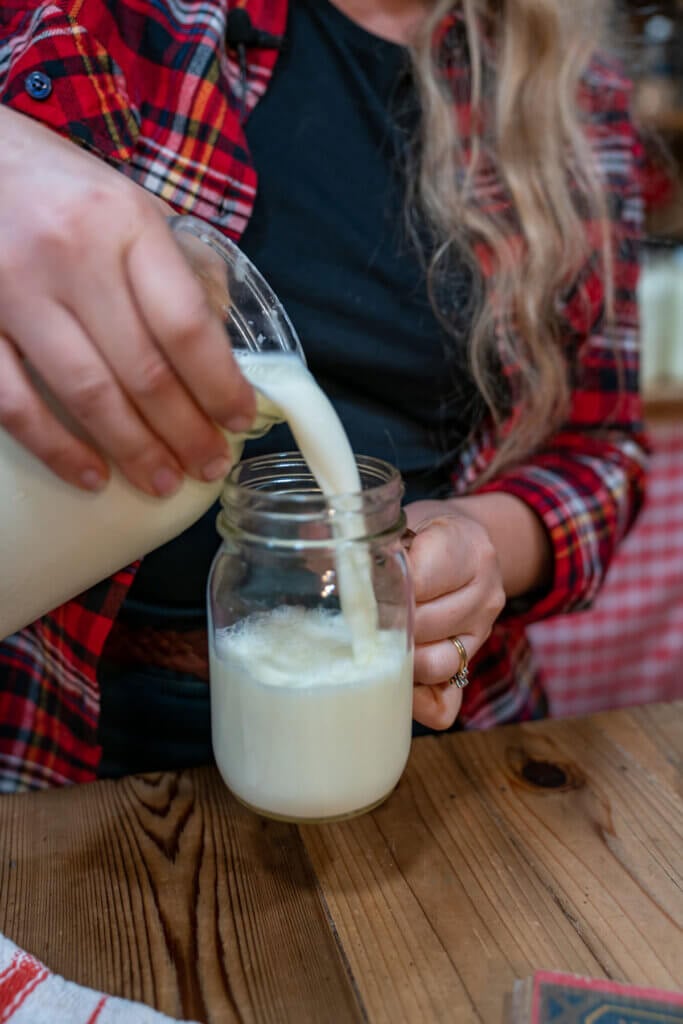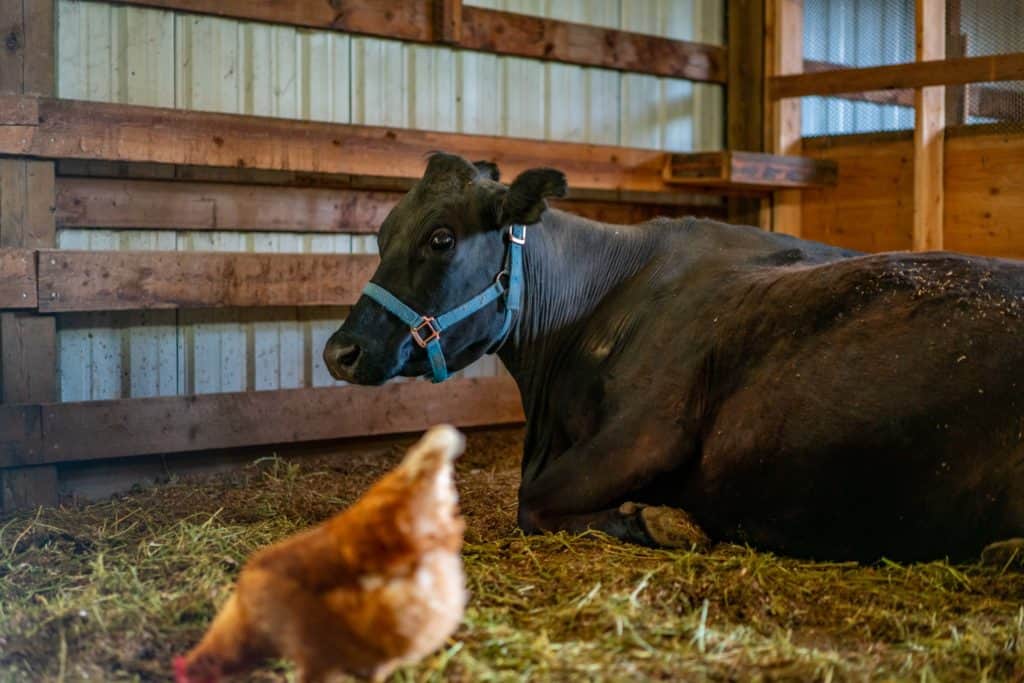








Raw milk is a wonderful product to have an abundance of. Learn what to do with raw milk when there’s plenty coming in during the summer months.

When it comes to producing food for our family, our dairy animals are our second most productive asset. Preserving dairy products in the summer for the winter months is like giving your future self a gift.
We love enjoying fresh homemade kefir, homemade yogurt, cream cheese, raw milk cottage cheese, and freeze-dried ice cream throughout the summer. We also love building up a well-stocked pantry with things like hard cheeses, chevre cheese (with our raw goat’s milk), and our favorite, yogurt cheese marinated in olive oil.
Preserving food in the summer and fall is a big part of homesteading. We not only preserve milk, but we preserve our fruit and veggies, we preserve meat by canning, we preserve fresh eggs in a lime-water solution, and we even preserve fresh greens as a Super Greens Powder.
Properly Handling Raw Milk
Many people are concerned with consuming raw milk. However, fresh milk straight from a healthy milk cow is very clean and safe to consume. (Source) The trouble comes when your milk touches contaminated tools or containers you’re working with, or is contaminated through unsanitary conditions and practices.
It seems our great-great-grandparents knew the health benefits of unpasteurized raw milk long before we did. They were consuming it for centuries before pasteurization became normal practice.
You will want to be sure all your tools and equipment have been washed well in hot soapy water. And be sure you’re following proper food safety practices before any raw milk comes into contact with the tool.
This means everything from the hands that are milking the cow, the bucket or container you’re milking into, the jars you’re storing the milk in, the funnels you’re using, even the teats of the animal… EVERYTHING needs to be nice and clean.
It’s important to note that I am not a certified medical practitioner. This post is not intended to diagnose or treat but is for informational purposes only. Please contact your healthcare professional before introducing new herbal and natural remedies into your wellness routine.

Anatomy of Raw Milk
When milk comes out of the animal, it has a lot of fat in it. Depending on the breed and diet of the milk cow, there will be varying degrees of fat.
Typically, the amount of cream in raw milk is a lot more than what’s considered “whole milk” at the grocery store (which contains about 4% milkfat).

Though you can’t look at a jar of milk and see all the varying layers of milk products, there are, in fact, different aspects to raw milk. From the most dense heavy cream, to the skimmed milk that settles at the bottom. Here are the different products you can get:
- Heavy Cream – Once you’ve milked the cow and placed it into the refrigerator, the cream will continue to rise to the top of the jar for up to 48 hours. If you allow it to sit a full 48 hours, the very top of the cream will be what’s considered heavy cream. This heavy cream is wonderful for churning into butter, homemade cream cheese, or making homemade ice cream in an ice cream maker.
- Half & Half or Thin Cream – The middle cream, just below the heavy cream, will be a thinner consistency than heavy cream but thicker than the cream just above the milk line. This “thin cream” is equivalent to that of half and half from the grocery store. Half & Half is excellent to use when culturing cream into sour cream and can also be great when making ice cream and some other soft cheeses.
- Coffee Cream or Light Cream – Finally, the very lowest part of the cream is called light cream. It’s just about the consistency of the milk itself, except the color will be that of cream. This thinnest cream is often referred to as coffee cream. This is what we recommend leaving with the milk. The amount left behind will usually represent true whole milk (about 4%).
- Skimmed Milk, Not “Skim Milk” -When skimming your milk, it’s best to skim off the heavy cream and the half-and-half cream but leave the light cream. The light cream is then mixed back into the milk (usually by shaking the container each time before pouring a glass of milk). We refer to this as “skimmed milk,” not to be confused with “skim milk” or nonfat milk (0% milkfat) from the store. We don’t recommend drinking a true skim milk (or 0%) as the fat content in raw milk is so healthy for your digestive system. (Source) It helps to offset the sugar content (or lactose) in the milk, making digestion easier. Homesteading Hack: If you have a lactose intolerance, drinking skim milk is one of the worst things you could do. You’re making it the most difficult for your body to process that lactose without any fat present in the milk itself. (Source)

What can you do with raw milk?
Raw milk can be consumed as is, or you can turn it into various other dairy products using the following methods:
- Clabbering
- Fermenting
- Culturing
Clabbered Milk
Clabbered milk happens simply by leaving fresh, raw milk out at room temperature for 4-5 days or until it thickens (or by using previously clabbered milk to innoculate the milk, which will then clabber more quickly).
After this time the milk will separate into curds and whey and will resemble yogurt. It can then be eaten as is or strained and turned into cottage cheese or our favorite, dream cheese.
While your clabbered milk should never smell bad, occasionally if your milk is very clean, it will take nearly two weeks for it to clabber. This length of time can create some odd smells and tastes and might not be very pleasant. While this long clabber is not bad for you, it won’t likely taste very good. But the good news is, if you take this long clabber and use a few spoonfuls as a starter culture in another batch of clabber, the next batch, and every batch thereafter, will culture much more quickly and have a much better smell and flavor. It may smell slightly sour and possibly a bit yeasty, but usually we stop the clabbering process when it still has a pleasant sweet, maybe just a bit tangy smell (like that of yogurt) by placing these subsequent batches in the refrigerator as soon as our taste buds deem them ready.
We always say, “Raw milk doesn’t go bad, it goes different!”
Watch this video to see how to clabber milk.
Visit the following link if you’re interested in learning how we make our “Dream Cheese” as mentioned in the video above.
Cultured Milk
This is when you add a certain strain of bacteria to the raw or pasteurized milk to make it culture in a certain way, with predictable tastes and textures.
This is what you do when you make cheese, yogurt and even kefir.
Sometimes the good bacteria in the raw milk can compete with added bacteria and will prevent your milk from culturing the way you desire. If this happens, you may want to consider pasteurizing your milk before culturing. You can also find great tips and tricks for culturing raw milk products online.

Storing Raw Milk
If you’re thinking of getting a dairy cow, you’ll really want to have your storage system in place before bringing a cow home. We currently get approximately six gallons of raw milk a day! So, if you don’t have a storage system ready, you’ll be wasting a lot of milk. (Or you’ll have a full-time job processing that fresh milk each and every day!)
Milk should stay nice and sweet, when properly handled and refrigerated, for up to two weeks. Once it’s past this point, it’s still good to use for baking or culturing, but won’t taste sweet when poured into a glass.
Learn how to freeze or freeze-dry milk and check out this post filled with recipes that use up a lot of milk.

Know Your State’s Raw Milk Laws
Each state has its own raw milk laws and ordinances regarding raw milk. Some states, such as Idaho, can actually sell it in the grocery store and in restaurants when proper licenses are acquired. Sadly, there are still many states where selling raw milk is prohibited or illegal.
Some states allow you to buy into a herd share where you’re essentially the part owner of a cow. You then pick up your milk each week from the farmer. In other states, as long as it’s marked “not for human consumption” it can be sold as pet food. What you do with it beyond that point is your choice.
No matter how you get your raw milk, it’s a wonderful and healthy product to have.


















